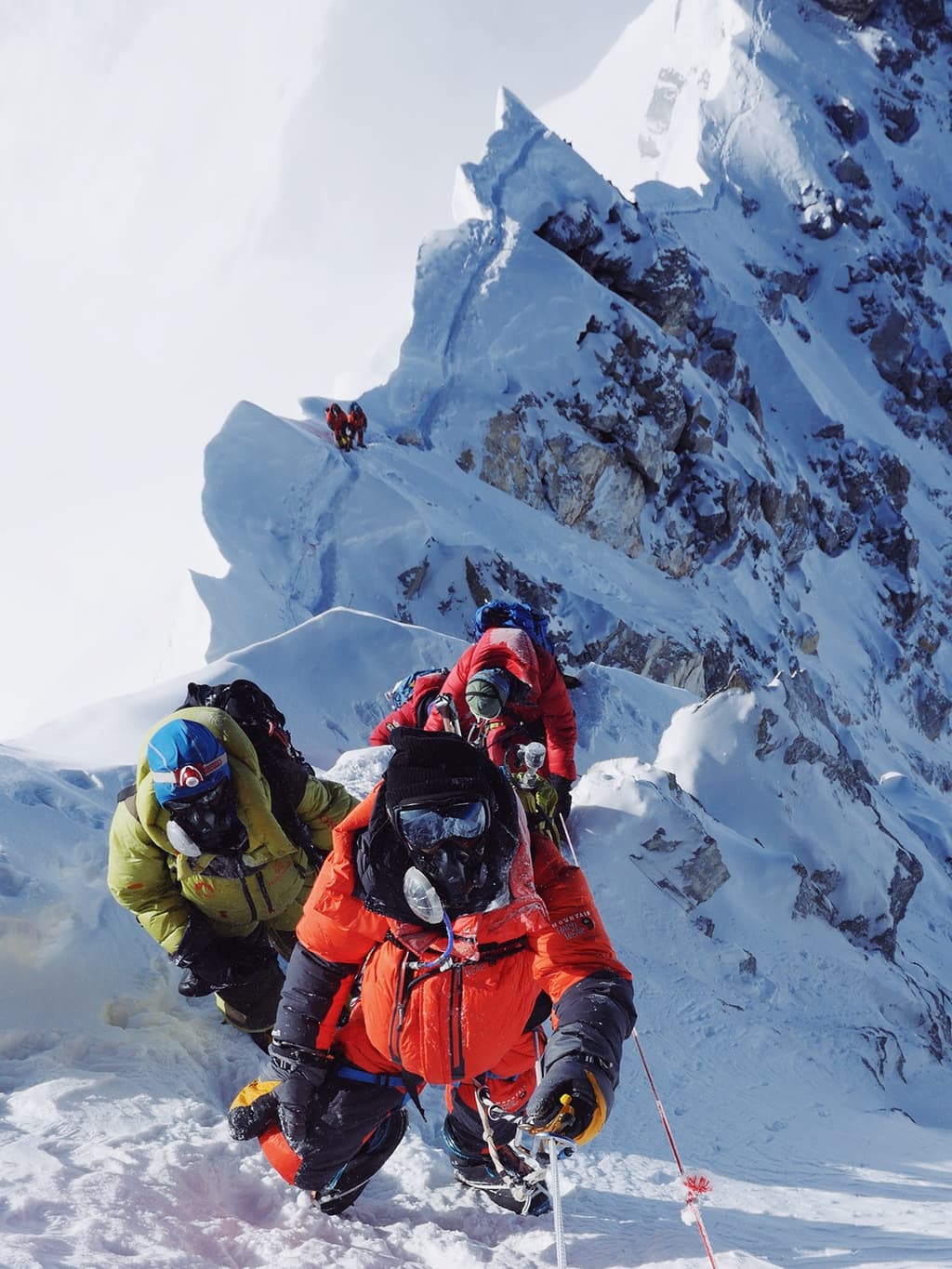Looking for your next mountaineering challenge? Annapurna South (7,219m) offers serious climbers an incredible alternative to overcrowded peaks. Our Everest Sherpa Expeditions team has guided adventurers up this majestic mountain for many years, combining technical climbing with authentic cultural experiences.
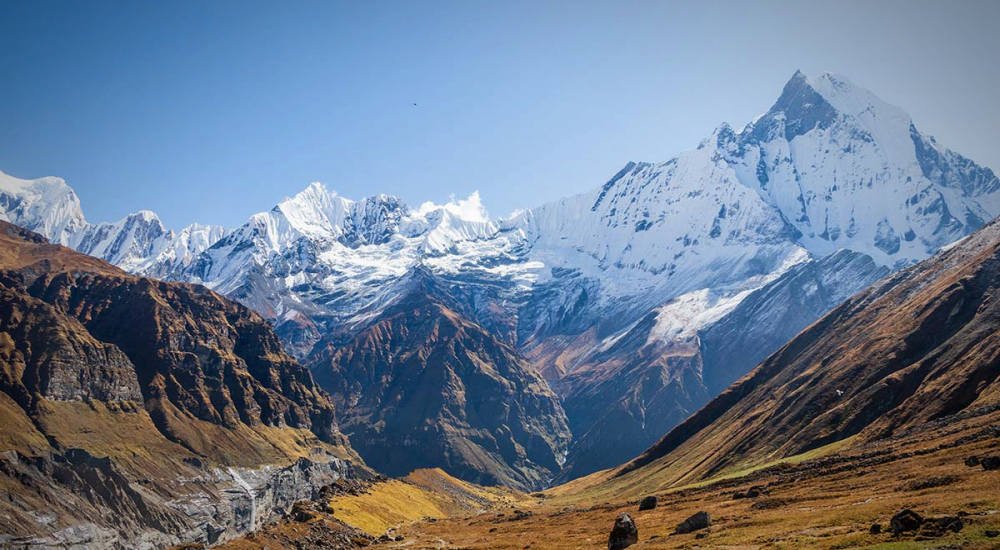
In this guide, we'll walk you through our proven preparation strategy for Annapurna South's unique challenges, including acclimatization schedules and essential gear recommendations. We'll also break down our carefully planned climbing route with key camp positions and safety protocols that have earned us a 92% summit success rate.
Ready to tackle one of the Himalayas' most rewarding expeditions? Let's explore what makes Annapurna South special and how our local Sherpa expertise makes all the difference.
Annapurna South: The Majestic Peak
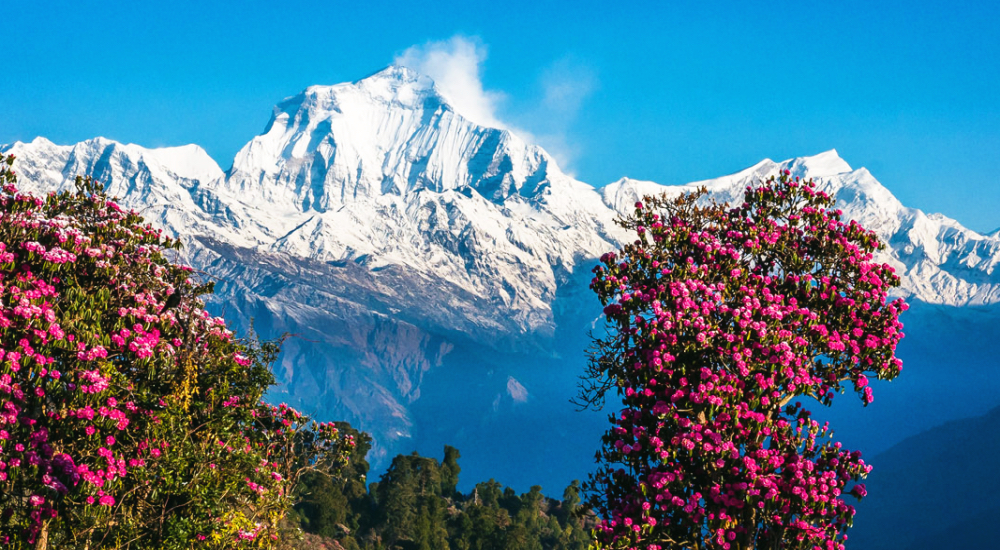
Geographic overview and location in the Himalayas
We've spent years exploring the magnificent Annapurna massif, and Annapurna South stands as one of its most impressive peaks. Located in north-central Nepal, this mountain forms part of the stunning Annapurna range within the greater Himalayas. We often tell our clients that its precise coordinates (28°31'N, 83°48'E) place it just southwest of Annapurna I, creating that iconic skyline visible from the popular trekking hub of Pokhara.
The mountain rises dramatically above the Modi Khola valley, offering breathtaking views from the Annapurna Sanctuary. During our expeditions, we've found that the mountain's accessibility from the beautiful Annapurna Base Camp makes it particularly special among Himalayan peaks.
Height, prominence, and notable features
Standing proud at 7,219 meters (23,684 feet), Annapurna South isn't the tallest in the range, but what it lacks in height, it makes up for in character. We've always been impressed by its prominent south face - a steep wall of rock and ice that presents serious challenges even to experienced climbers.
The mountain features several distinct ridges, with the southeast ridge offering what we consider the most feasible climbing route. What makes this peak particularly striking is its sharply defined summit pyramid and the massive glaciers that cling to its slopes. The glacier systems on Annapurna South are extensive and ever-changing, something we carefully monitor each season for safe passage.
Comparison with other Annapurna peaks
The Annapurna massif contains several magnificent peaks, each with unique characteristics:
|
Peak |
Height |
Notable Features |
Climbing Difficulty |
|
Annapurna I |
8,091m |
10th highest mountain, first 8000er climbed |
Extremely high |
|
Annapurna South |
7,219m |
Prominent pyramid summit, accessible base camp |
High |
|
Annapurna II |
7,937m |
Remote location, technical climbing |
Very high |
|
Annapurna III |
7,555m |
Steep faces, seldom climbed |
Very high |
|
Gangapurna |
7,455m |
Dramatic north face, hanging glaciers |
High |
We've guided expeditions on several of these peaks, and can attest that while Annapurna South doesn't reach the extreme altitude of Annapurna I, it presents its own set of significant challenges.
Historical significance in mountaineering
Annapurna South holds a special place in mountaineering history. The first ascent came in 1964 by a Japanese expedition, opening up a new chapter for the Annapurna massif. We've always found it fascinating that despite being lower than its famous neighbor Annapurna I (which was the first 8000-meter peak ever climbed in 1950), Annapurna South remained unconquered for an additional 14 years.
Throughout the decades, numerous routes have been established on its faces and ridges. We've witnessed how this mountain has become an important stepping stone for climbers preparing for higher Himalayan peaks. Many of our clients use Annapurna South as preparation before attempting 8000-meter mountains.
The peak has claimed its share of lives too, reminding us of the respect these mountains demand. Every time we guide climbers here, we honor those who pioneered routes on this magnificent mountain.
Preparing for Your Annapurna South Expedition

Best seasons for climbing
Tackling Annapurna South isn't something you do on a whim. Timing matters—a lot. We've found that pre-monsoon (April-May) and post-monsoon (October-November) offer the most stable weather conditions.
During spring, days grow longer, temperatures rise, and the mountain shows off with spectacular rhododendron blooms below base camp. The autumn season brings crystal-clear skies with unmatched visibility—perfect for those summit panoramas you're dreaming about.
We avoid summer months entirely (June-September). The monsoon brings heavy rainfall, obscured views, and dangerous conditions with increased avalanche risk. Winter (December-February)? Too brutal with extreme cold and high winds that make climbing nearly impossible.
Required permits and documentation
Getting the paperwork right is crucial before we hit the trail. For Annapurna South, we need:
-
Annapurna Conservation Area Permit (ACAP): $30 per person
-
Expedition Permit: $1,800 for the team (spring), $900 (autumn)
-
Climbing Insurance: Must cover high-altitude rescue up to 7,000m
-
Garbage Deposit: $500 (refundable upon return with proper waste management)
We handle all this paperwork for you, but you'll need to provide:
-
Valid passport with at least 6 months validity
-
Digital passport photos
-
Signed liability waiver
-
Medical certificate confirming fitness for high-altitude climbing
Essential gear and equipment checklist
The right gear can make or break your expedition. Our essential packing list includes:
Technical Climbing Gear:
-
Ice axe and crampons
-
Climbing harness with locking carabiners
-
Ascenders and descenders
-
Helmet
-
Fixed and dynamic ropes
Clothing:
-
Down suit for summit day
-
Multiple insulating layers
-
Waterproof/windproof outer layers
-
High-altitude boots with inner boots
-
Climbing socks (4+ pairs)
-
Insulated gloves with shell mittens
Personal Equipment:
-
Expedition-quality sleeping bag (-30°C rating)
-
Sleeping pads (inflatable and foam)
-
Headlamp with extra batteries
-
UV protection sunglasses (category 4)
-
High SPF sunscreen and lip balm
We provide group equipment including tents, cooking gear, and oxygen systems. Our detailed equipment guide arrives after booking.
Physical conditioning and training recommendations
We'll be straight with you—Annapurna South demands serious physical preparation. Start training at least 6 months before departure with:
-
Cardiovascular Endurance: 4-5 sessions weekly combining long-distance running, cycling, and swimming
-
Strength Training: Focus on legs and core with weighted step-ups, lunges, and planks
-
Load Bearing: Regular hikes with a 15-20kg pack, gradually increasing duration and elevation gain
-
Specific Training: Stair climbing with a weighted pack simulates the repetitive uphill movement
Weekend training should include back-to-back long days (6+ hours) on steep terrain to build stamina and recovery capacity. We've seen direct correlation between pre-expedition fitness and summit success.
Acclimatization strategies
Proper acclimatization isn't optional—it's essential for both safety and summit success. Our expedition follows the "climb high, sleep low" principle with a carefully planned ascent profile.
We build in multiple acclimatization days at critical elevation points:
-
2-3 days at Base Camp (4,130m)
-
Day hikes to higher elevations followed by descent
-
Rotation to Camp 1 (5,300m) with return to Base Camp
-
Gradual progression through camps with rest days
Hydration is crucial—we aim for 4-5 liters daily. Our medical kit includes Diamox (acetazolamide) as a preventative measure, though we prefer natural acclimatization whenever possible.
We monitor oxygen saturation levels throughout the expedition and maintain flexible scheduling to accommodate individual acclimatization needs. Summit push only begins when everyone shows proper adaptation to the altitude.
Everest Sherpa Expeditions' Unique Approach
Our experienced Sherpa team and guides
When it comes to conquering Annapurna South, the guides you choose make all the difference. Our Sherpa team isn't just experienced—they're legendary. Most have summited 8,000m peaks multiple times, including Annapurna South, Everest, and K2. But impressive resumes aside, what sets our team apart is their deep connection to these mountains.
Our lead guides have grown up in the shadow of the Himalayas, with climbing traditions passed down through generations. This isn't just a job for them—it's their heritage. We've carefully built our team over 15 years, selecting members not just for technical skills but for their leadership, problem-solving abilities, and warm personalities.
The ratio of guides to climbers on our expeditions is among the highest in the industry (1:2), ensuring personalized attention throughout your journey.
Safety protocols and emergency procedures
Your safety isn't just a priority—it's our obsession. We've developed comprehensive safety systems through decades of expedition experience.
Every Annapurna South expedition includes:
-
Daily weather forecasts from multiple international sources
-
Satellite phones and emergency communication devices
-
Supplemental oxygen and hyperbaric chambers
-
Comprehensive medical kits with prescription medications
-
Pre-placed rescue equipment at critical points
We conduct thorough pre-expedition health screenings and maintain direct helicopter evacuation partnerships that can deploy within hours. Our guides undergo annual wilderness first responder training and high-altitude medical certification.
The mountains are unpredictable, but our response isn't. We've refined our emergency protocols through real-world experience, allowing us to make critical decisions quickly when conditions change.
Sustainable and responsible climbing practices
The mountains have given us everything, so we're committed to protecting them for future generations. Our "Zero Impact" approach means we leave nothing behind—literally nothing. We actually remove more waste than we bring, collecting abandoned equipment and trash from previous expeditions.
We've eliminated single-use plastics from our operations, using only reusable or biodegradable alternatives. Our base camp energy comes from portable solar systems, and we use only sustainable fuel sources at higher camps.
But sustainability goes beyond environmental practices. We pay our staff above-industry wages and provide comprehensive insurance benefits to all team members. When you climb with us, you're supporting fair labor practices in the climbing industry.
Cultural sensitivity and local relationships
The Annapurna region isn't just stunning mountains—it's home to rich cultural traditions and communities that have thrived here for centuries. We've built deep relationships with local villages, employing community members and purchasing supplies locally whenever possible.
Before each expedition, we brief our clients on local customs, appropriate behavior at monasteries and sacred sites, and how to respectfully interact with local communities. We contribute a portion of every expedition fee to community development projects selected by village leaders themselves.
Many of our clients tell us that these cultural experiences become the most meaningful memories from their journey. The mountains may be why you come, but the people and their stories will capture your heart.
The Climbing Route
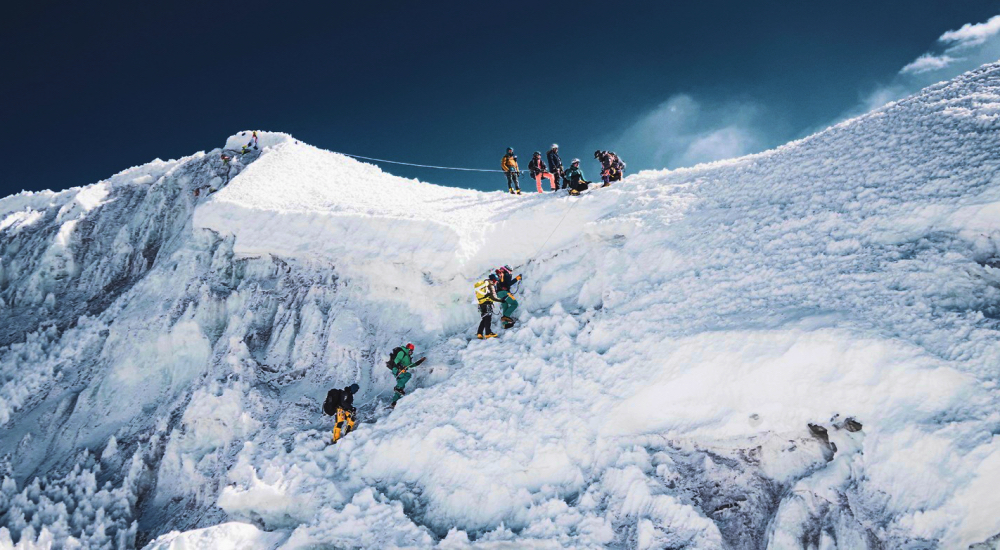
Base camp location and facilities
We've established our Annapurna South Base Camp at 4,130 meters in a relatively sheltered area with stunning views of the mountain. Our camp sits on a glacial moraine that offers solid ground for tents and facilities. The setup includes comfortable sleeping tents, a spacious dining tent with tables and chairs, and separate kitchen facilities where our experienced Sherpa cooks prepare nutritious meals to keep your energy levels high.
We provide hot showers at base camp – a rare luxury that our climbers absolutely love after tough acclimatization climbs. Our communication center includes satellite phones and internet access, allowing you to stay connected with loved ones. We've also equipped the base camp with solar panels to power essential equipment and charge your devices.
Major camps and their elevations
Our expedition involves four strategically placed camps above base camp:
|
Camp |
Elevation |
Description |
|
Camp 1 |
5,400m |
Located on a snow plateau after navigating the icefall |
|
Camp 2 |
6,100m |
Positioned on a relatively flat section below the face |
|
Camp 3 |
6,700m |
Established on a narrow snow ridge with protection from winds |
|
Camp 4 |
7,100m |
Our highest camp, set up on a small plateau before the summit push |
Each camp is stocked with essential supplies, emergency equipment, and oxygen for the higher camps. We employ a rotation system to ensure proper acclimatization between camps.
Technical challenges along the route
The journey from base camp to Camp 1 presents the first major challenge – navigating through an icefall zone with crevasses and seracs. We fix ropes here for safety and typically tackle this section very early in the morning when the ice is more stable.
Between Camp 1 and Camp 2, we face a steep snow slope (40-50°) that requires solid crampon technique. The section from Camp 2 to Camp 3 includes mixed climbing with some rock sections and a narrow ridge that demands careful movement while clipped to fixed lines.
The most technically demanding section comes between Camp 3 and Camp 4, where we encounter a 60° ice wall that requires front-pointing with crampons and efficient ice axe technique. This section is physically demanding at that altitude.
Summit day strategy and timing
We typically start our summit push from Camp 4 around midnight. This timing is crucial – it gives us enough hours of darkness when the snow is more stable and reduces avalanche risk, while ensuring we reach the summit with plenty of daylight for the descent.
Our summit day strategy involves moving in small groups with Sherpa guides maintaining a sustainable pace. We set strict turnaround times based on weather conditions and individual climber's progress. No matter how close to the summit, if we hit the turnaround time, we head down – the mountain will always be there another day.
We use supplemental oxygen from Camp 3 onwards, with flow rates adjusted based on individual needs and elevation. Our Sherpas carry extra oxygen bottles and emergency equipment. The descent from the summit back to Camp 4 is often the most dangerous part, as fatigue sets in. We maintain the same level of caution and safety protocols on the way down as on the way up.
Cultural Experiences Beyond the Climb
Local villages and communities along the trek
While conquering Annapurna South is our primary mission, the journey through local villages enriches the expedition beyond measure. As we ascend, we pass through charming settlements like Ghandruk and Chhomrong, where traditional Gurung architecture still stands proud against the backdrop of towering peaks.
These villages aren't just stops on our map—they're living, breathing communities where generations have thrived in harmony with the mountains. In Ulleri, stone staircases wind between homes perched impossibly on steep hillsides. The people here wave from their doorways, children trailing behind our trekking group with curious smiles.
We make it a point to spend quality time in these villages rather than rushing through. The pace slows as we wander narrow pathways, past prayer flags fluttering in the mountain breeze and locals tending to their daily routines.
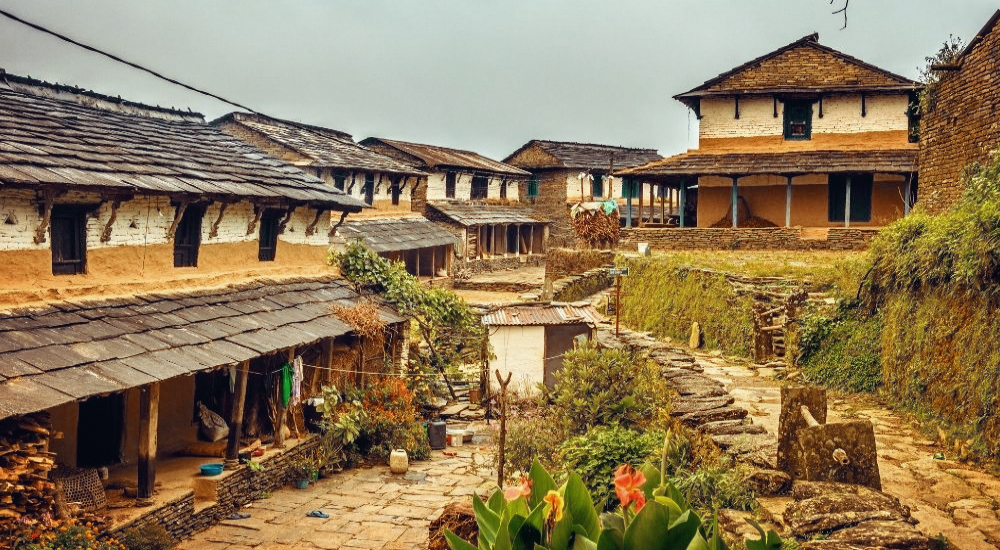
Traditional Nepali customs and hospitality
Nothing compares to Nepali hospitality. We're welcomed into teahouses with warm smiles and a cup of steaming chai that somehow tastes infinitely better at altitude.
The tradition of "Namaste"—hands pressed together, slight bow—isn't just a greeting here but a genuine expression of respect that we experience countless times daily. Village elders share stories around evening fires, passing down legends that have shaped these mountain communities for centuries.
During our expeditions, we often witness traditional ceremonies that mark important life events or seasonal celebrations. The rhythmic dancing, vibrant costumes, and haunting melodies provide a cultural counterpoint to our physical journey.
Authentic food experiences in the region
The food along our Annapurna South route deserves its own special mention. Dal bhat—lentil soup with rice, vegetables and sometimes meat—becomes our power food, with locals proudly announcing "dal bhat power, 24 hour!" Each village adds their own twist to this staple dish.
We encourage our climbers to try momos (dumplings) stuffed with local vegetables or yak meat, served with spicy achar (pickle). In higher villages, Sherpa stew—a hearty mix of vegetables, meat and noodles—warms us from the inside out after long trekking days.
The apple pies in Marpha are legendary among trekkers, while raksi (homemade rice or millet alcohol) offered during special occasions provides a potent taste of local tradition. These authentic food experiences create lasting memories as powerful as summiting itself.
Practical Information and Booking
Expedition Duration and Itinerary Highlights
Our Annapurna South Expedition runs for 28 days, giving you plenty of time to acclimatize properly and maximize your summit chances. We've crafted an itinerary that balances climbing days with crucial rest periods:
-
Days 1-2: Arrival in Kathmandu, permit arrangements, equipment check
-
Days 3-5: Drive to Pokhara, trek to Base Camp (4,130m)
-
Days 6-12: Acclimatization, training, and establishing Camp 1 (5,100m) and Camp 2 (5,700m)
-
Days 13-22: Summit window, with final push to Camp 3 (6,400m) and summit attempt (7,219m)
-
Days 23-28: Descent to Base Camp, return to Pokhara and Kathmandu
The beauty of this schedule? We build in extra days for weather delays or additional acclimatization if needed.
All-Inclusive Package Details
Our standard Annapurna South package includes everything you need for a successful expedition:
|
Included |
Details |
|
Permits |
All climbing and conservation area permits |
|
Transportation |
Airport transfers, Kathmandu-Pokhara transport |
|
Accommodation |
4 nights hotel in Kathmandu, 2 nights in Pokhara, all camping during trek |
|
Meals |
All meals on the mountain, welcome/farewell dinners |
|
Staff |
Experienced climbing Sherpas (1:2 ratio), cooks, porters |
|
Equipment |
Group climbing gear, tents, cooking equipment, oxygen (2 bottles) |
|
Support |
Base camp facilities including communication equipment |
Optional Services and Add-Ons
Want to customize your expedition? We've got options:
-
Personal Sherpa guide (1:1 ratio): $2,500
-
Extra oxygen bottles: $550 per bottle
-
Satellite phone rental: $300 for the expedition
-
Custom food requests: Starting from $200
-
Extended stay in Kathmandu: $85 per night
-
Private helicopter evacuation insurance: $450
We can also arrange pre-expedition climbs on smaller peaks for additional acclimatization if you're looking to maximize your chances.
The journey to Annapurna South offers more than just a mountaineering challenge—it's a transformative adventure through one of Nepal's most breathtaking landscapes. From meticulous preparation and expert guidance by Everest Sherpa Expeditions to the carefully planned climbing routes, every aspect of the expedition is designed to maximize both safety and your connection with this majestic peak. Along the way, the rich cultural experiences and encounters with local communities add depth to your Himalayan adventure.
Ready to embark on your own Annapurna South expedition? Join the ranks of successful climbers who have trusted Everest Sherpa Expeditions with their Himalayan dreams. Our experienced guides, comprehensive support, and attention to detail ensure you'll have the adventure of a lifetime. Contact us today to book your expedition and take the first step toward conquering one of the world's most magnificent mountains.
If you need any further information, please contact us by email: [email protected], Phone: +977- 980 195 6248 (WhatsApp).

